Trade-Offs between Sustainability Indicators in Response to the Production Choices of Different Farm Household Types in Drylands
Abstract
1. Introduction
2. Materials and Methods
2.1. Description of the Study Area
2.2. Analytical Method Used to Characterize the Diversity and Performance of Farm Households
2.2.1. Farm Household Data
2.2.2. Typology of Farm Households
- Criteria that account for resource endowment
- Criteria that account for production goals
- Criteria that account for levels of production intensification
2.3. Assessment of Sustainability-Related Indicators
2.3.1. Farm Income as an Economic Indicator
2.3.2. Self-Consumption as a Nutritional Indicator
2.3.3. Technical Efficiency as an Input-Use Performance Indicator
2.3.4. Agro-Biodiversity as an Environmental Indicator
- H: Shannon-Winner agro-biodiversity index,
- i: subscript for number of species,
- ni: number of occurrences of cultivated crop i on the farm,
- S: total number of occurrences of all crops found on the farm (also known as the specific wealth),
- Pi: proportion of crop i on the farm in relation to S.
3. Results and Discussion
3.1. Description of the Farming and Cropping Systems in the Study Area
3.2. Description of Distinctly Dominant Farm Households
3.2.1. Farm Household Typology
3.2.2. Identification of Distinct Farm Household Types
- Intensive predominantly-vegetable farming households
- Semi-intensive cereal mono-crop farming households
- Extensive mixed cereal-legume farming households
3.3. Sustainability-Related Indicator Trade-Off Analysis
4. Conclusion
Author Contributions
Funding
Acknowledgments
Conflicts of Interest
Appendix A
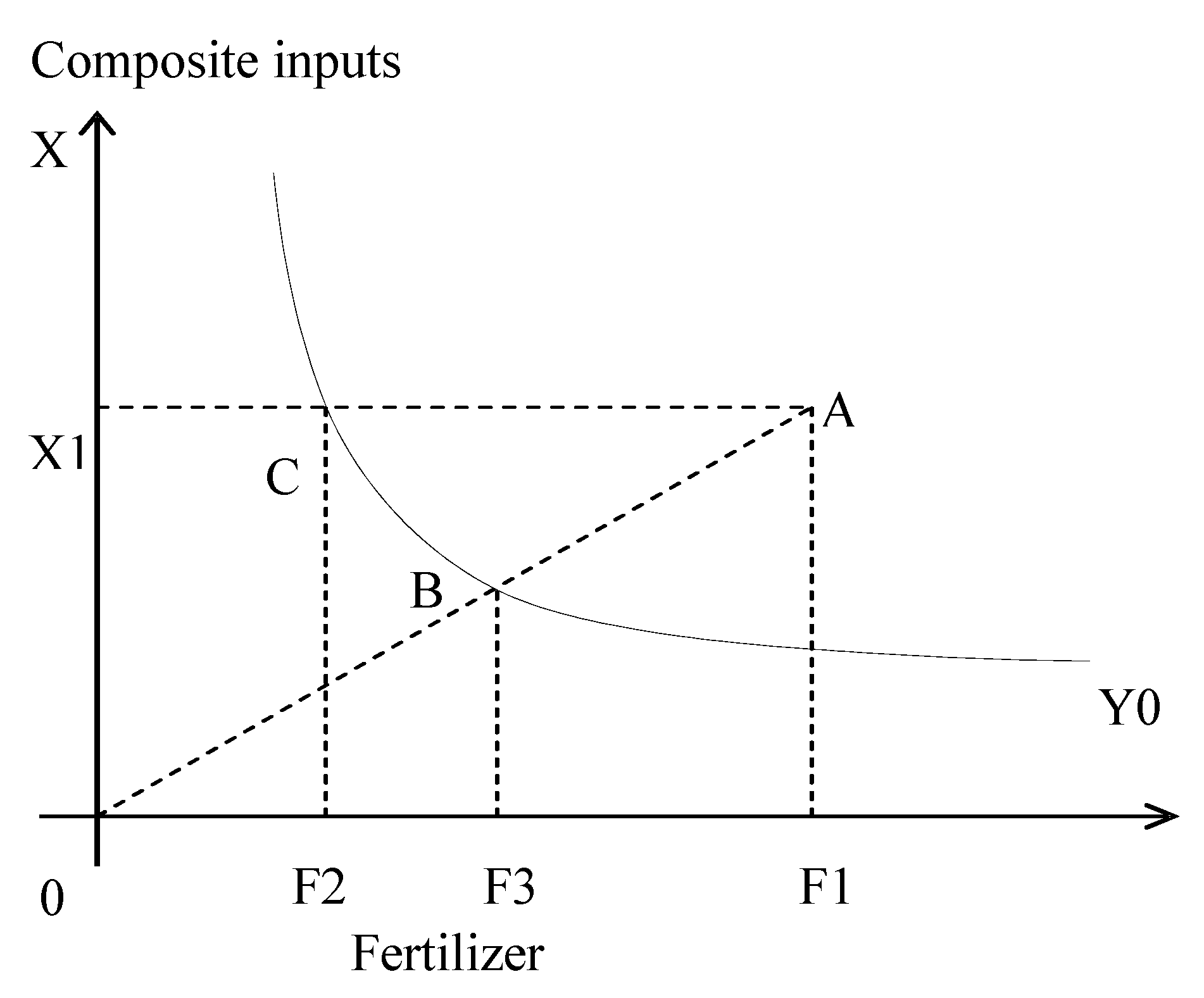
Appendix B

References
- García-Palacios, P.; Alarcón, M.R.; Tenorio, J.L.; Moreno, S.S. Ecological intensification of agriculture in drylands. J. Arid. Environ. 2019, 167, 101–105. [Google Scholar] [CrossRef]
- Mrabet, R.; Moussadek, R.; Fadlaoui, A.; van Ranst, E. Conservation agriculture in dry areas of Morocco. Field Crop. Res. 2012, 132, 84–94. [Google Scholar] [CrossRef]
- Shalander, K.; Amare, H.; Ramilan, T.; Suhas, P.W. Assessing different systems for enhancing farm income and resilience in extreme dry region of India. In Proceedings of the 58th AARES Annual Conference, Port Macquarie, Australia, 4–7 February 2014; p. 22. [Google Scholar]
- Hervieu, B.; Abis, S.; Blanc, P.; de Jouvenel, H. Mediterra 2008: The Future of Agriculture and Food in Mediterranean Countries; Presses de Sciences Po: Paris, France, 2008; p. 356. [Google Scholar]
- Souissi, I.; Boisson, J.M.; Mekki, I.; Therond, O.; Flichman, G.; Wery, J.; Belhouchette, H. Impact assessment of climate change on farming systems in the South Mediterranean area: A Tunisian case study. Reg. Environ. Chang. 2018, 18, 637–650. [Google Scholar] [CrossRef]
- Aït Kadi, M.; Benoit, G.; Lazaref, G. L’Union pour la Méditerranée face aux crises alimentaires, de l’eau et du climat. Les Notes d’analyse du CIHEAM 2008, 42, 1–25. (In French) [Google Scholar]
- Robinson, L.W.; Ericksen, P.J.; Chesterman, S.; Worden, J.S. Sustainable intensification in drylands: What resilience and vulnerability can tell us. Agric. Syst. 2015, 135, 133–140. [Google Scholar] [CrossRef]
- Fadlaoui, A.; Allali, K.; Yjjou, M.; Ezzahouani, A.; Zahri, A. Rapport d’activités sur l’état d’avancement du Projet CRP D.S dans la Province d’El Hajeb; INRA-Maroc: Rabat, Morocco, 2013; p. 30. (In French) [Google Scholar]
- Chenoune, R.; Allen, T.; Komarek, A.M.; Paloma, S.G.Y.; Flichman, G.; Capillon, A.; Belhouchette, H. Assessing consumption-production-resources nexus decisions for rice-focused agricultural households in Sierra Leone. Land Use Policy 2017, 67, 597–607. [Google Scholar] [CrossRef]
- FAO. Profil Nutritionnel de Pays: Royaume du Maroc; FAO: Rome, Italy, 2011; p. 60. (In French) [Google Scholar]
- Tilman, D.; Cassman, K.G.; Matson, P.A.; Naylor, R.; Polasky, S. Agricultural sustainability and intensive production practices. Nature 2002, 418, 671–677. [Google Scholar] [CrossRef]
- Human Rights Council. Promotion and protection of all human rights, civil, political, economic, social and cultural rights, including the right to development. In Report of The Special Rapporteur on the Right to Food, Jean Ziegler; Human Rights Council: Genève, Switzerland, 2008; p. 27. [Google Scholar]
- CEA-AN. La sécurité Alimentaire en Afrique du Nord: Analyse de Situation et réactions des états Face à l’instabilité des marchés Agricoles; Commission économique pour l’Afrique, Bureau pour l’Afrique du Nord, Nations Unies: Rabat, Morocco, 2012; p. 48. (In French) [Google Scholar]
- Hadi, M.M.; Heinrich, M.D. Plan stratégique de Pays–Liban (2018–2020); Programme Alimentaire Mondial: Rome, Italy, 2017; p. 32. (In French) [Google Scholar]
- Medany, M.A. Climate change: Impacts and responses for sustainable agriculture in Egypt. CIHEAM Watch Lett. 2016, 37, 69–74. [Google Scholar]
- Saoud, B. Le plan maroc vert: Stratégie, objectifs et gouvernance de mise en œuvre. Comptes Rendus de l’Académie d’agriculture de France 2011, 97, 27–28. (In French) [Google Scholar]
- Baccar, M.; Bouaziz, A.; Dugue, P.; Le Gal, P.Y. Shared environment, diversity of pathways: Dynamics of family farming in the Sais Plain (Morocco). Reg. Environ. Chang. 2017, 17, 739–751. [Google Scholar] [CrossRef]
- Sohrabi, M.; Heidari, G.; Mohammadi, S.; Yazdanseta, S. Evaluation of quantitative and qualitative characteristics of yield in dryland wheat cultivars under supplemental irrigation conditions. J. Food Agric. Environ. 2010, 8, 400–403. [Google Scholar]
- Belhouchette, H.; Louhichi, K.; Therond, O.; Mouratiadou, I.; Wery, J.; van Ittersum, M.; Flichman, G. Assessing the impact of the nitrate directive on farming systems using a bio-economic modelling chain. Agric. Syst. 2011, 104, 135–145. [Google Scholar] [CrossRef]
- Blazy, J.M.; Tixier, P.; Thomas, A.; Ozier-Lafontaine, H.; Salmon, F.; Wery, J. BANAD: A farm model for ex ante assessment of agro-ecological innovations and its application to banana farms in Guadeloupe. Agric. Syst. 2010, 103, 221–232. [Google Scholar] [CrossRef]
- Lopez-Ridaura, S.; Frelat, R.; van Wijk, M.T.; Valbuena, D.; Krupnik, T.J.; Jat, M.L. Climate smart agriculture, farm household typologies and food security: An ex-ante assessment from Eastern India. Agric. Syst. 2018, 159, 57–68. [Google Scholar] [CrossRef]
- Peano, C.; Migliorini, P.; Sottile, F. A methodology for the sustainability assessment of agri-food systems: An application to the Slow Food Presidia project. Ecol. Soc. 2014, 19. [Google Scholar] [CrossRef]
- Smith, A.; Snapp, S.; Chikowo, R.; Thorne, P.; Bekunda, M.; Glover, J. Measuring sustainable intensification in smallholder agroecosystems: A review. Glob. Food Secur. 2017, 12, 127–138. [Google Scholar] [CrossRef]
- Delmotte, S.; Barbier, J.M.; Mouret, J.C.; Le Page, C.; Wery, J.; Chauvelon, P.; Sandoz, A.; Ridaura, S.L. Participatory integrated assessment of scenarios for organic farming at different scales in Camargue, France. Agric. Syst. 2016, 143, 147–158. [Google Scholar] [CrossRef]
- Mandryk, M.; Reidsma, P.; van Ittersum, M.K. Crop and farm level adaptation under future climate challenges: An exploratory study considering multiple objectives for Flevoland, the Netherlands. Agric. Syst. 2017, 152, 154–164. [Google Scholar] [CrossRef]
- Reidsma, P.; Janssen, S.; Jansen, J.; van Ittersum, M.K. On the development and use of farm models for policy impact assessment in the European Union: A review. Agric. Syst. 2018, 159, 111–125. [Google Scholar] [CrossRef]
- Haileslassie, A.; Craufurd, P.; Thiagarajah, R.; Kumar, S.; Whitbread, A.; Rathor, A.; Blummel, M.; Ericsson, P.; Kakumanu, K.R. Empirical evaluation of sustainability of divergent farms in the dryland farming systems of India. Ecol. Indic. 2016, 60, 710–723. [Google Scholar] [CrossRef]
- Belhadj Hamlili, C. Impact de la pollution nitrique sur les ressources en eaux souterraines dans la plaine de Saïss (Maroc). In Mémoire (Master 2 GAT); CIHEAM-IAMM: Montpellier, France, 2012. (In French) [Google Scholar]
- Kmoch, L.; Pagella, T.; Palm, M.; Sinclair, F. Using local agroecological knowledge in climate change adaptation: A study of tree-based options in Northern Morocco. Sustainability 2018, 10, 3719. [Google Scholar] [CrossRef]
- ABHS. Etude de la faisabilité de Transfert du Haut Sebou Vers la Plaine du Saiss: Rapport de synthèse; Agence du Bassin Hydraulique du Sebou: Fès, Morocco, 2006; p. 27. (In French) [Google Scholar]
- Zraibi, L. Comportement Agronomique, Biochimique et Physiologique d’accessions de CARTHAME (Carthamustinctorius L.) vis-à-vis de Contraintes Environnementales Thèse de Doctorat; Faculté des Sciences: Oujda, Algeria, 2013. (In French) [Google Scholar]
- Mrabet, R.; Fadlaoui, A.; Moussadak, R. Caractérisation des sites: Meknès-El Hajeb. In Proceedings of the Atelier de Lancement CRP-DS, Meknès, Morocco, 7–8 November 2013. [Google Scholar]
- Dugué, P.; Benouniche, M.; Ameur, F.; El Amrani, M.; Kuper, M. Lorsque les agriculteurs familiaux innovent: Cas des systèmes de production irrigués de la plaine du Saïs (Maroc). Agron. Environ. Sociétés 2015, 5, 87–95. [Google Scholar]
- Chenoune, R.; Belhouchette, H.; Paloma, S.G.Y.; Capillon, A. Assessing the diversity of smallholder rice farms production strategies in Sierra Leone. NJAS–Wagening. J. Life Sci. 2016, 76, 7–19. [Google Scholar] [CrossRef]
- Bossa, A.Y.; Diekkruger, B.; Giertz, S.; Steup, G.; Sintondji, L.O.; Agbossou, E.K.; Hiepe, C. Modeling the effects of crop patterns and management scenarios on N and P loads to surface water and groundwater in a semi-humid catchment (West Africa). Agric. Water Manag. 2012, 115, 20–37. [Google Scholar] [CrossRef]
- Madry, W.; Pluta, S.; Sieczko, L.; Studnicki, M. Phenotypic diversity in a sample of blackcurrant (Ribes nigrum L.) cultivars maintained in the Fruit Breeding Department at the Research Institute of Pomology and Floriculture in Skierniewice, Poland. J. Fruit Ornam. Plant Res. 2010, 18, 23–37. [Google Scholar]
- Bidogeza, J.C.; Berentsen, P.B.M.; De Graaff, J.; Lansink, A. A typology of farm households for the Umutara Province in Rwanda. Food Secur. 2009, 1, 321–335. [Google Scholar] [CrossRef]
- Alvarez, S.; Paas, W.; Descheemaeker, K.; Tittonell, P.; Groot, J. Typology Construction, A Way of Dealing with Farm Diversity: General Guidelines for Humidtropics; Wageningen University & CGIAR: Wageningen, The Netherlands, 2014; p. 36. [Google Scholar]
- Hammond, J.; Fraval, S.; van Etten, J.; Suchini, J.G.; Mercado, L.; Pagella, T.; Frelat, R.; Lannerstad, M.; Douxchamps, S.; Teufel, N.; et al. The Rural Household Multi-Indicator Survey (RHoMIS) for rapid characterisation of households to inform climate smart agriculture interventions: Description and applications in East Africa and Central America. Agric. Syst. 2017, 151, 225–233. [Google Scholar] [CrossRef]
- Gelasakis, A.I.; Rose, G.; Giannakou, R.; Valergakis, G.E.; Theodoridis, A.; Fortomaris, P.; Arsenos, G. Typology and characteristics of dairy goat production systems in Greece. Livest. Sci. 2017, 197, 22–29. [Google Scholar] [CrossRef]
- USDA. Agricultural Research Service: U.S. Department of Agriculture. Available online: https://fdc.nal.usda.gov/index.html (accessed on 11 May 2020).
- Calories. Tableau Des Calories. Available online: http://www.gastronomie-wallonne.be/gastro/articles_cuisine/tableau_des_calories.pdf (accessed on 11 May 2020).
- Fatsecret. Fatsecret Australia. Available online: https://www.fatsecret.com.au/ (accessed on 11 May 2020).
- Keating, B.A.; Carberry, P.S.; Bindraban, P.S.; Asseng, S.; Meinke, H.; Dixon, J. Eco-efficient agriculture: Concepts, challenges, and opportunities. Crop. Sci. 2010, 50, 109–119. [Google Scholar] [CrossRef]
- Farrell, M.J. The measurement of productive efficiency. J. R. Stat. Soc. Ser. A (Gen.) 1957, 120, 253–290. [Google Scholar] [CrossRef]
- Coelli, T. A guide to DEAP version 2.1: A data envelopment analysis (computer) program. In CEPA Working Paper; University of New England: Armidale, Australia, 2008; pp. 1–49. [Google Scholar]
- Yigezu, Y.A.; Ahmed, M.A.; Shideed, K.; Aw-Hassan, A.; El-Shater, T.; Al-Atwan, S. Implications of a shift in irrigation technology on resource use efficiency: A Syrian case. Agric. Syst. 2013, 118, 14–22. [Google Scholar] [CrossRef]
- Torres, A.C. Revue Bibliographique des Outils Pour la Mesure des Relations Entre Agrobiodiversité et Nutrition. Master’s Thesis, La Sécurité Alimentaire pour le Développement, Université Paris Sud–Faculté Jean Monnet, Paris, France, 2013. (In French). [Google Scholar]
- Elloumi, M. L’agriculture tunisienne dans un contexte de libéralisation. Région et Développement 2006, 32, 130–160. (In French) [Google Scholar]
- Bedrani, S.; Abidar, A.; Laytimi, A. National Agriculture Policy: Algeria [MEDFROL Project]; European Union: Brussels, Belgium, 2005; p. 41. [Google Scholar]
- Radwan, A.; Gil, J.M.; Diab, Y.A.A.; Abo-Nahoul, M.A. Determinants of the adaption of organic agriculture in Egypt using a duration analysis technique. In Proceedings of the Agricultural Economic Society Annual Conference, Warwick, UK, 18–20 April 2011; p. 12. [Google Scholar]
- Harper, H.; Hallsworth, M. Counting Calories: How Under-Reporting Can Explain the Apparent Fall in Calorie Intake; Behavioural Insights Team: Londres, UK, 2016; p. 43. [Google Scholar]
- Komarek, A.M.; Drogue, S.; Chenoune, R.; Hawkins, J.; Msangi, S.; Belhouchette, H.; Flichman, G. Agricultural household effects of fertilizer price changes for smallholder farmers in central Malawi. Agric. Syst. 2017, 154, 168–178. [Google Scholar] [CrossRef]
- Ferchiou, A. Quelles Mesures de Relances Pour l’agriculture Familiale en Zone Aride: évaluation Intégrée par la Modélisation bio économique des Ménages Agricoles de Sidi Bouzid. Ph.D. Thesis, Montpellier SupAgro, Montpellier, France, 2017. (In French). [Google Scholar]
- Jouve, A.-M.; Belghazi, S.; Kheffache, Y. La filière des céréales dans les pays du Maghreb: Constante des enjeux, évolution des politiques. In Les Agricultures Maghrébines à l’aube de l’an 2000; Options Méditerranéennes: Série B. Etudes et Recherches; Allaya, M., Ed.; CIHEAM: Montpellier, France, 1995; Volume 14, pp. 169–192. (In French) [Google Scholar]
- Dobermann, A.; Nelson, R. Solutions for Sustainable Agriculture and Food Systems: Technical Report for the Post–2015 Development Agenda; Sustainable Development Solutions Network: New York, NY, USA, 2013; p. 108. [Google Scholar]
- FAO. Ethique et Intensification Agricole Durable; FAO: Rome, Italy, 2004; p. 33. [Google Scholar]
- Dugué, P.; Soulard, C.; Marrachini, E.; Houdart, M.; Michel, I.; Rhaidour, M. Systèmes maraichers urbains et périurbains en Méditerranée: Une comparaison entre Meknès (Maroc), Montpellier (France) et Pise (Italie). In Proceedings of the Journées Scientifiques Franco-Tunisiennes: Organisation des Agriculteurs et des Systèmes Agricoles dans les Territoires Urbains et Périurbains, Sousse, Tunisia, 9 March 2016; p. 10. [Google Scholar]
- Lacirignola, C. Les Objectifs du Développement Durable: Opportunités Méditerranéennes; L’Harmattan: Paris, France, 2016; p. 221. [Google Scholar]
- Payne, W. Integrated Agricultural Production Systems for Improved Food Security and Livelihoods in Dry Areas: Inception Phase Report; CGIAR Research Program on Aquatic Agricultural Systems: Amman, Jordan, 2013; p. 72. [Google Scholar]
- Battese, G.E.; Coelli, T.J. A model for technical inefficiency effects in a stochastic frontier production function for panel data. Empir. Econ. 1995, 20, 325–332. [Google Scholar] [CrossRef]
- Reinhard, S.; Lovell, C.A.K.; Thijssen, G. Econometric estimation of technical and environmental efficiency: An application to dutch dairy farms. Am. J. Agric. Econ. 1999, 81, 44–60. [Google Scholar] [CrossRef]
- Kopp, R.J. The measurement of productive efficiency: A reconsideration. Q. J. Econ. 1981, 96, 477–503. [Google Scholar] [CrossRef]
- Akridge, J.T. Measuring productive efficiency in multiple product agribusiness firms: A dual approach. Am. J. Agric. Econ. 1989, 71, 116–125. [Google Scholar] [CrossRef]
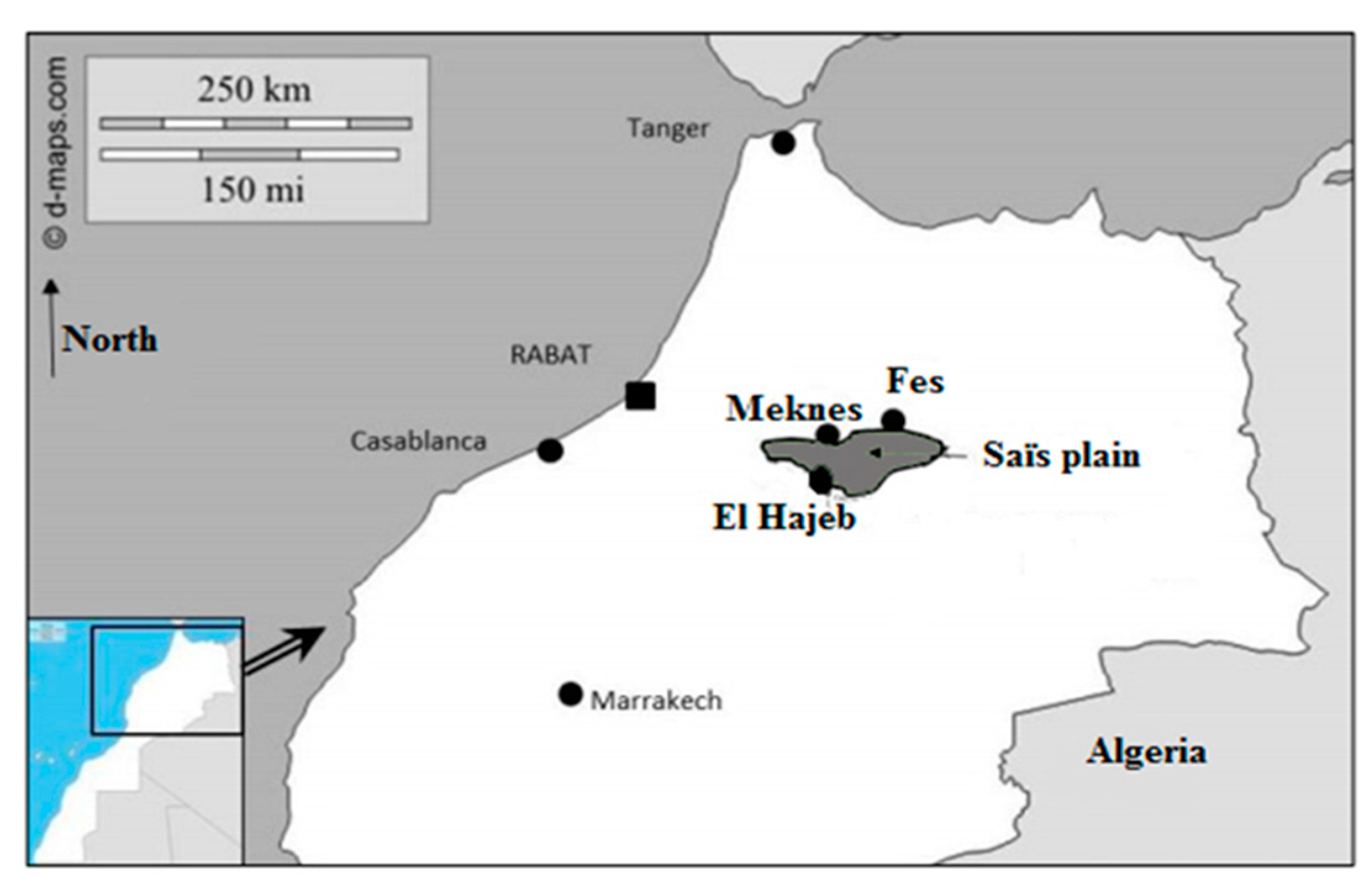
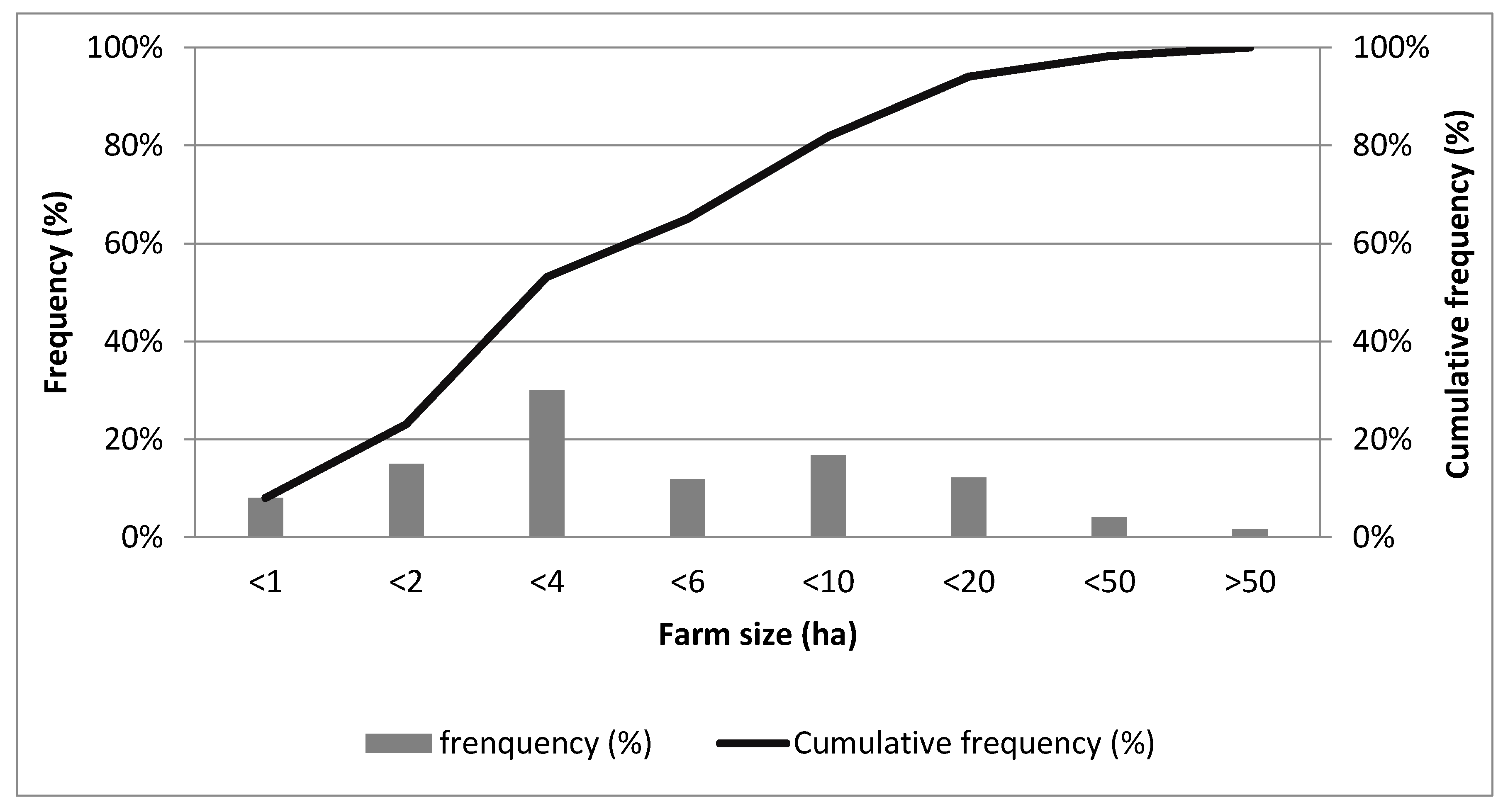
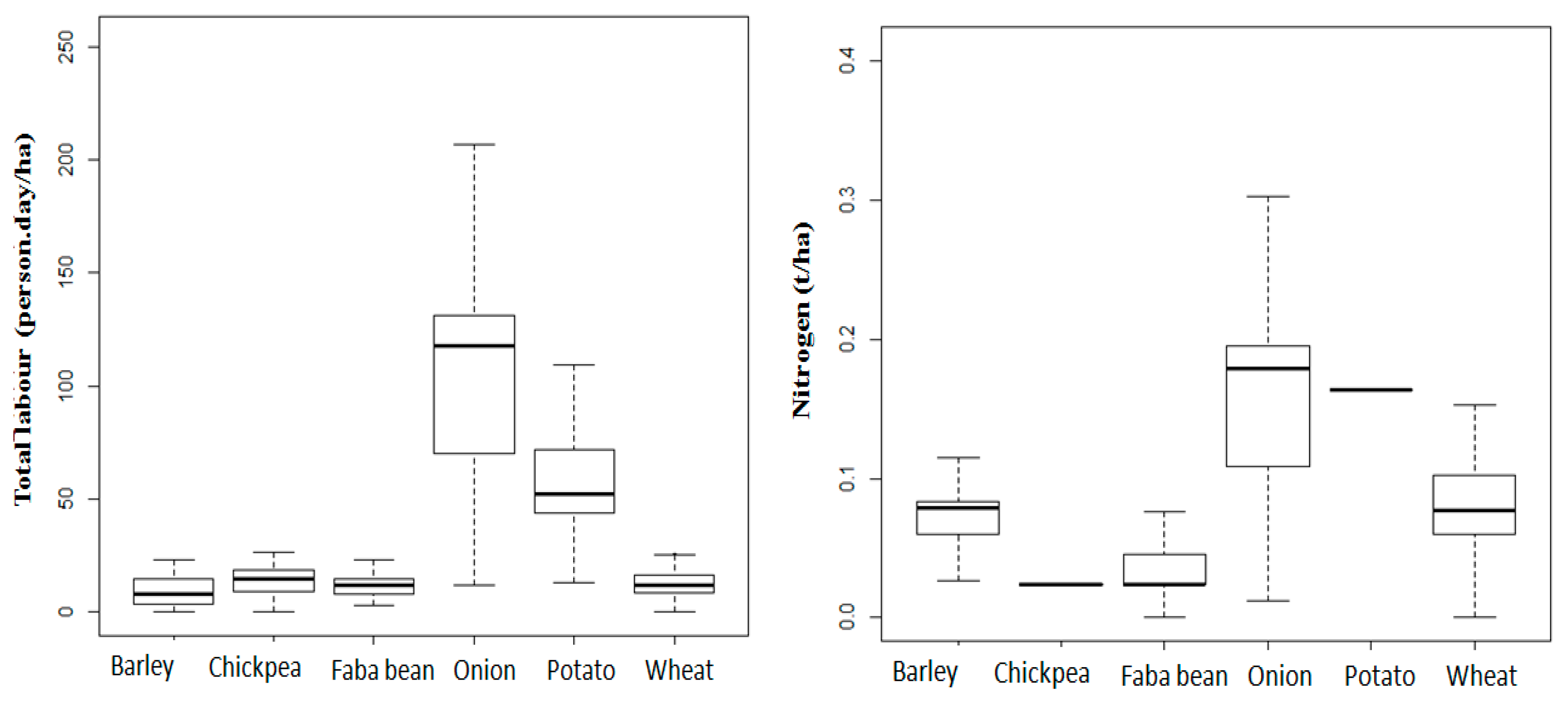
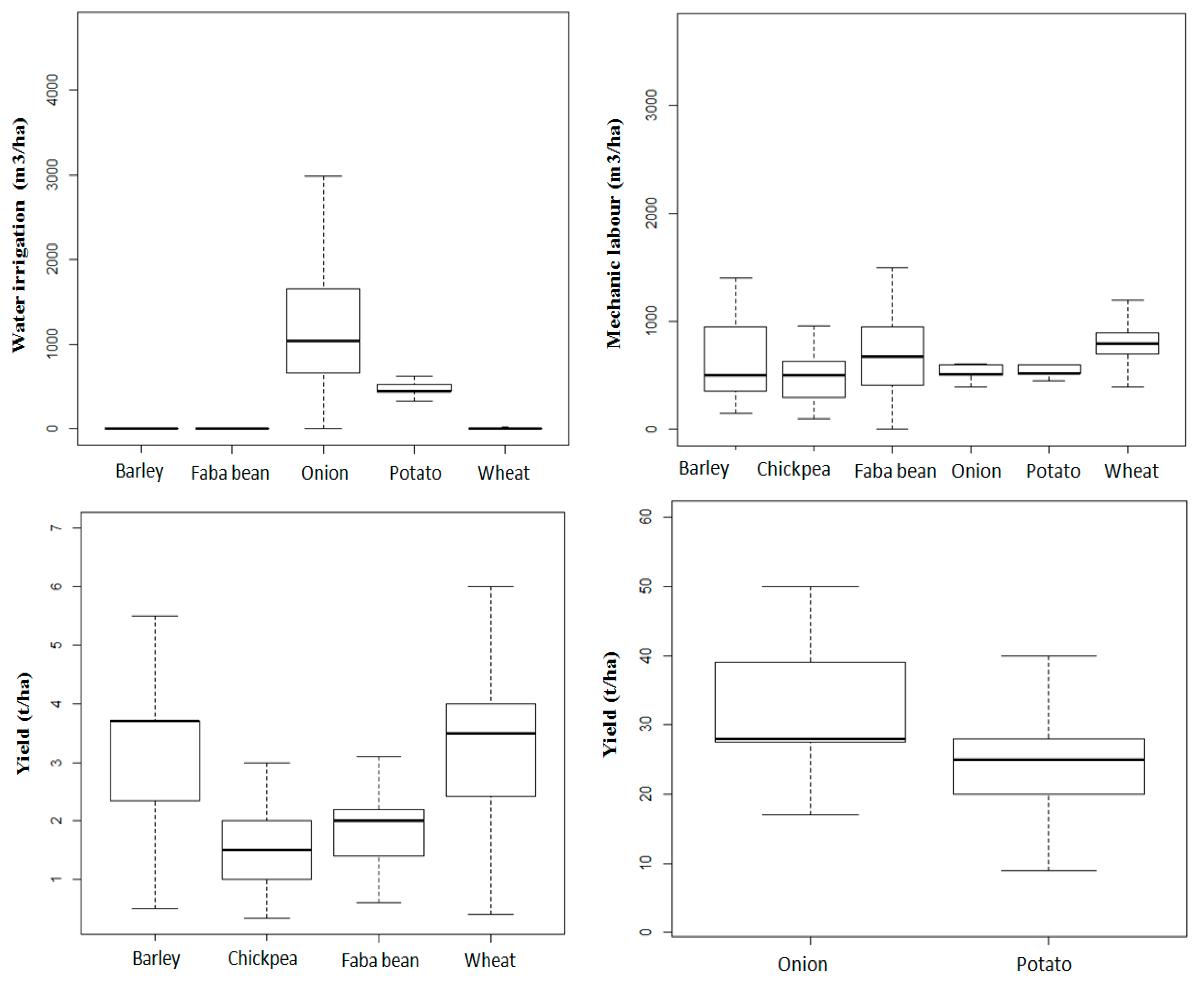

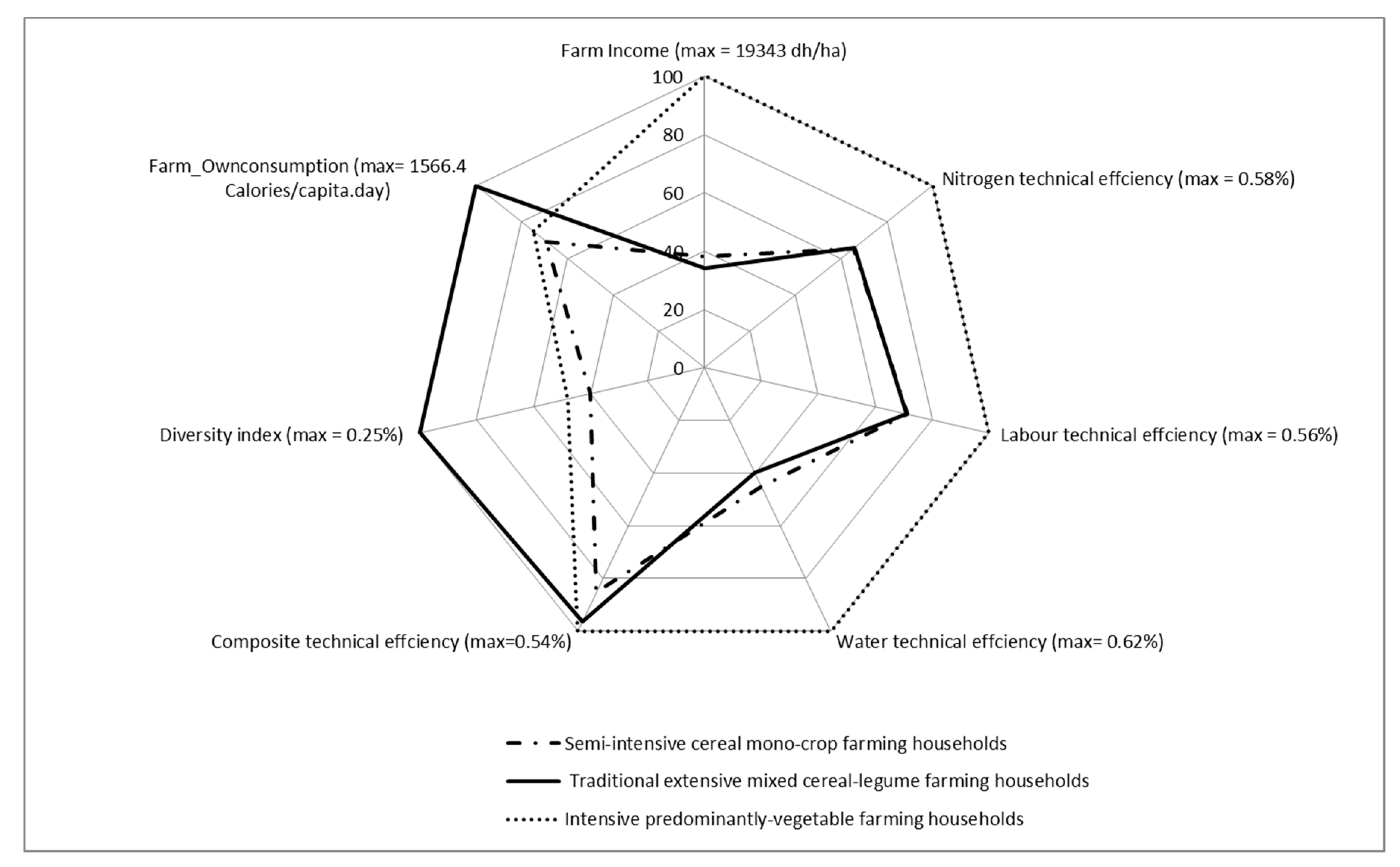
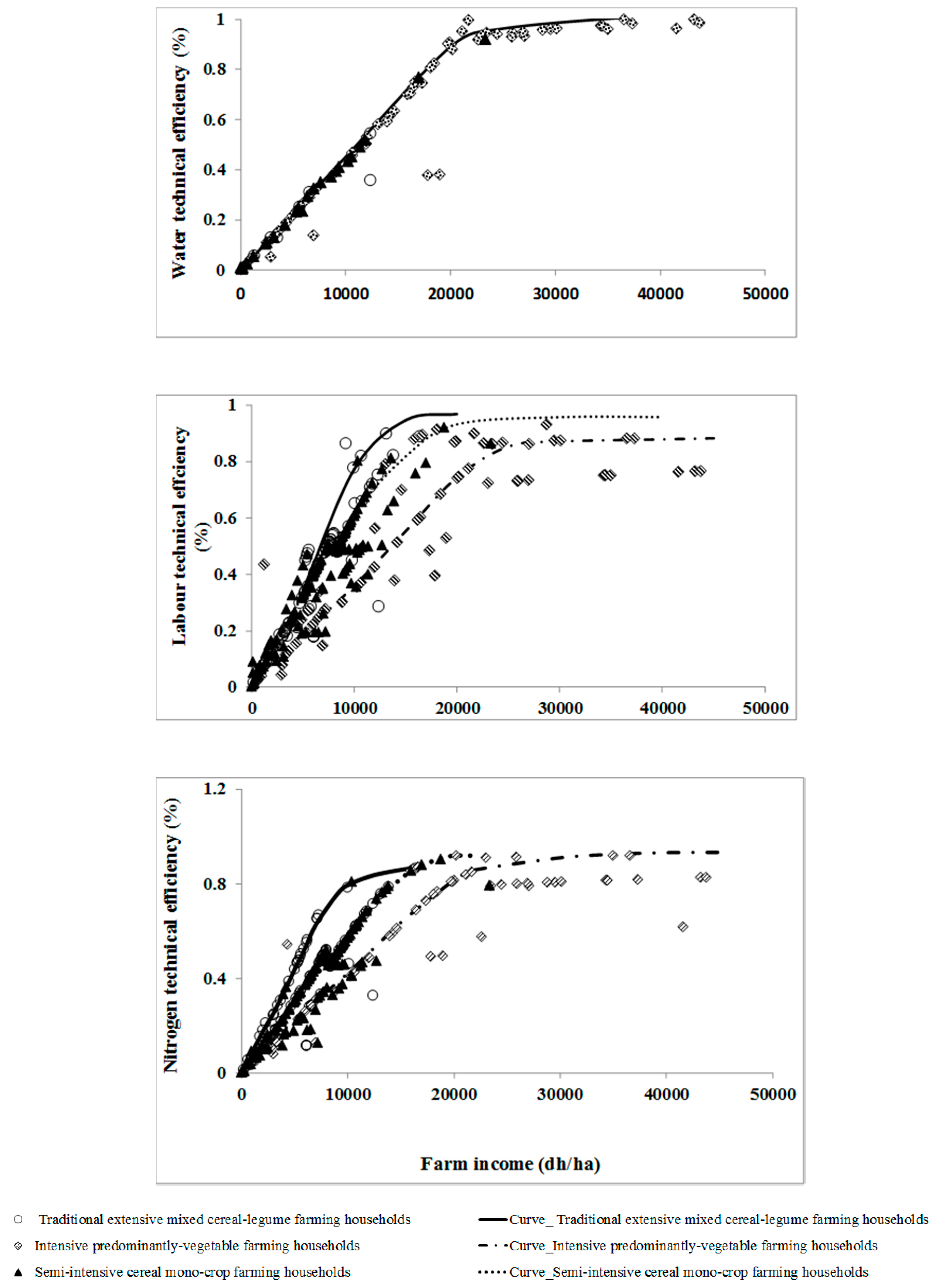
| Criteria for Farm Typology | Variables for Farm Typology | Source of Data | |
|---|---|---|---|
| Criteria that account for resource endowment | Production potential | 1- Cropped area per farm household (ha) | Primary data from survey |
| 2- Irrigated area per farm (%) | Calculated from the survey as a percentage of irrigated area over the total cropped farm area. | ||
| Availability of financial resources | 3- Gross margin per farm from cultivated crops (dh/ha) | Calculated from the survey first per crop by considering production and costs, and then at farm level | |
| 4- Number of animals per type (sheep) | Primary data from survey | ||
| 5- Number of animals per type (cattle) | |||
| 6- Off-farm income (dh/household) | |||
| Criteria that account for production intensification | 7- Total quantity of irrigation water per farm (m3/ha) | For each crop and then farm, they were calculated from the survey as the quantity of each input multiplied by the market price of each input as given by each farmer. | |
| 8- Total labour per farm (person-day/ha) | |||
| 9- Total mechanization cost per farm (dh/ha) | |||
| 10- Total cost of seeds per crop_Onion (dh/ha) | |||
| 11- Total cost of seeds per crop_Potato (dh/ha) | |||
| 12- Total cost of seeds per crop_Wheat (dh/ha) | |||
| 13- Total cost of seeds per crop_faba bean (dh/ha) | |||
| 14- Total cost of seeds per crop_Barley (dh/ha) | |||
| 15- Total cost of seeds per crop_Chickpea (dh/ha) | |||
| 16- Total quantity of N fertilization per farm (kg/ha) | |||
| Criteria that account for production goals | 17- Family working population size | Primary data from survey | |
| 18- % of production per type of cereal products 19- % of production per type of vegetable products 20- % of production per type of legume products | Per farm, it was calculated as a percentage of income ensured by each type of product (cereals, legumes, and vegetables) over the total farm income. | ||
| 21- % of calories provided from self-consumption per type of cereal products 22- % of calories provided from self-consumption per type of vegetable products 23- % of calories provided from self-consumption per type of legume products | Calculated from the survey as a percentage of total calories provided by self-consumption per type of product (cereals, legumes, vegetables) | ||
| Variables | Min | First Quartile (q1) | Median | Max | Third Quartile (q3) |
|---|---|---|---|---|---|
| Family-size | 1.0 | 4.0 | 6.0 | 27.0 | 8.0 |
| Total cropped area (ha) | 0.5 | 1.9 | 3.0 | 86.0 | 7.0 |
| Farm gross margin (dh/ha) | 44.0 | 4585.8 | 7411.6 | 43,767.4 | 10,510.3 |
| Self-Consumption Per Product (kg/capita/year) | |||||
| Wheat | 0.0 | 149.0 | 300.0 | 881.5 | 500.0 |
| Barley | 0.0 | 0.0 | 7.9 | 397.5 | 94.0 |
| Faba bean | 0.0 | 0.8 | 3.9 | 28.3 | 14.2 |
| Chickpea | 0.0 | 0.0 | 2.2 | 16.8 | 6.6 |
| Onion | 0.0 | 8.7 | 15.2 | 145.5 | 38.2 |
| Potato | 0.0 | 17.4 | 40.3 | 118.2 | 66.7 |
| Criteria | Name of Variables | Components | |||||||
|---|---|---|---|---|---|---|---|---|---|
| Axis_1 | Axis_2 | Axis_3 | Axis_4 | Axis_5 | Axis_6 | Axis_7 | |||
| Criteria that account for resource endowment | Production potential | 1- Cropped area per farm household (ha) | 0.177 | 0.208 | 0.327 | −0.333 | 0.243 | −0.025 | −0.026 |
| 2- Irrigated area per farm (%) | −0.837 | −0.122 | −0.003 | 0.046 | −0.002 | −0.007 | −0.051 | ||
| Availability of financial resources | 3- Gross margin per farm from cultivated crops (dh/ha) | −0.471 | −0.142 | 0.494 | 0.356 | −0.016 | 0.000 | −0.092 | |
| 4- Number of animals per type (sheep) | 0.107 | 0.014 | 0.419 | −0.472 | −0.213 | 0.112 | −0.166 | ||
| 5- Number of animals per type (cattle) | 0.118 | −0.020 | 0.364 | −0.390 | 0.179 | −0.037 | 0.111 | ||
| 6- Off-farm income (dh/household) | −0.471 | −0.142 | 0.494 | 0.356 | −0.016 | 0.079 | 0.042 | ||
| Criteria that account for production intensification | 7- Total quantity of irrigation water per farm (m3/ha) | −0.810 | −0.161 | −0.114 | −0.224 | 0.076 | −0.005 | −0.022 | |
| 8- Total labour per farm (person-day/ha) | −0.820 | −0.163 | −0.140 | −0.166 | 0.081 | 0.052 | 0.002 | ||
| 9- Total mechanization cost per farm (dh/ha) | −0.017 | 0.189 | 0.590 | 0.087 | −0.109 | 0.028 | −0.069 | ||
| 10- Total cost of seeds per crop and farm_Onion (dh/ha) | −0.644 | −0.065 | −0.469 | −0.440 | 0.015 | −0.125 | 0.120 | ||
| 11- Total cost of seeds per crop and farm_Potato (dh/ha) | −0.568 | −0.058 | 0.549 | 0.390 | −0.015 | −0.055 | −0.261 | ||
| 12- Total cost of seeds per crop and farm_Wheat (dh/ha) | 0.533 | −0.573 | −0.245 | 0.200 | 0.222 | −0.079 | −0.025 | ||
| 13- Total cost of seeds per crop and farm_Faba bean (dh/ha) | 0.111 | 0.817 | −0.090 | 0.148 | −0.095 | 0.174 | −0.263 | ||
| 14- Total cost of seeds per crop and farm_Barley (dh/ha) | 0.216 | 0.010 | 0.208 | −0.411 | −0.696 | −0.005 | −0.022 | ||
| 15- Total cost of seeds per crop and farm_Chickpea (dh/ha) | 0.139 | 0.276 | 0.163 | −0.329 | 0.603 | 0.052 | 0.002 | ||
| Criteria that account for production goals | 16- Total quantity of N fertilization per farm (kg/ha) | −0.686 | −0.135 | 0.098 | 0.093 | −0.049 | 0.110 | 0.314 | |
| 17- Family working population size | −0.060 | −0.108 | 0.190 | −0.217 | 0.209 | −0.206 | 0.442 | ||
| 18- % of production per type of cereal products | 0.769 | −0.497 | −0.137 | −0.046 | −0.211 | 0.708 | 0.104 | ||
| 19- % of production per type of vegetable products | −0.937 | −0.142 | 0.168 | 0.057 | 0.051 | 0.653 | −0.049 | ||
| 20- % of production per type of legume products | 0.135 | 0.892 | −0.025 | −0.009 | 0.234 | −0.104 | −0.572 | ||
| 21- % of calories provided by self-consumption per type of cereal products | −0.809 | 0.010 | −0.186 | −0.154 | −0.062 | −0.016 | −0.385 | ||
| 22- % of calories provided by self-consumption per type of vegetables products | −0.809 | 0.010 | −0.186 | −0.154 | −0.062 | 0.222 | 0.115 | ||
| 23- % of calories provided by self-consumption per type of legume products | −0.012 | 0.801 | −0.157 | 0.180 | −0.151 | 0.042 | −0.023 | ||
| Eigenvalues | 6.418 | 3.244 | 1.933 | 1.601 | 1.310 | 1.133 | 1.034 | ||
| Cumulative explained variance (%) | 27.90 | 42.01 | 50.41 | 57.37 | 63.07 | 68 | 72 | ||
| Criteria | Variables | Intensive Predominantly-Vegetable Farming Households (n= 62) | Semi-Intensive Cereal Mono-Crop Farming Households (n= 140) | Extensive Mixed Cereal-Legume Farming Households (n= 85) |
|---|---|---|---|---|
| Production potential | Cropped area (ha) | 3.88 | 4.41 | 11.62 |
| Irrigated area (%) | 80 | 10 | 5 | |
| Availability of financial resources | Gross margin (dh/ha) | 19343 | 7378 | 6491 |
| Off-farm income (dh) | 3696 | 3627 | 2457 | |
| Total cattle (number) | 2.8 | 2.6 | 3.3 | |
| Total sheep (number) | 5.6 | 10.3 | 11.2 | |
| Production intensification | Water (m3/ha) | 577 | 41 | 6 |
| Labour (person-day/ha) | 56 | 15 | 11 | |
| Mechanization cost (dh/ha) | 647 | 768 | 586 | |
| Seed costs (dh/ha) | 1648 | 413 | 519 | |
| Nitrogen (kg/ha) | 143 | 83 | 60 | |
| Production goals | Family size (number) | 7 | 6 | 6 |
| Production_Cereals (%) | 26 | 61 | 73 | |
| Production_Legumes (%) | 4 | 11 | 25 | |
| Production_Vegetables (%) | 70 | 28 | 1.2 | |
| Self_consumption_Calories_Cereals (%) | 53 | 97 | 66 | |
| Self_consumption_Calories _Legume (%) | 2 | 2 | 31 | |
| Self_consumption_Calories _Vegetables (%) | 45 | 1 | 3 | |
| Diversity index | Shannon index | 0.12 | 0.1 | 0.25 |
| Intensive Predominantly-Vegetable Farming Households | Semi-Intensive Cereal Mono-Crop Farming Households | Extensive Mixed Cereal-Legume Farming Households | |||||||||||||||||
|---|---|---|---|---|---|---|---|---|---|---|---|---|---|---|---|---|---|---|---|
| Variable/Crops* | Cereals | Legumes | Vegetables | Cereals | Legumes | Vegetables | Cereals | Legumes | Vegetables | ||||||||||
| W | B | C | F | O | P | W | B | C | F | O | P | W | B | C | F | O | P | ||
| Area (ha) | 1.66 | 0.12 | 0.03 | 0.53 | 0.81 | 0.73 | 2.3 | 0.65 | 0.27 | 0.52 | 0.56 | 0.11 | 6.48 | 1.24 | 2.16 | 1.43 | 0.27 | 0.03 | |
| Yield (t/ha) | 3.7 | 3.7 | 1.2 | 1.7 | 33.2 | 25.4 | 3.4 | 2.9 | 1.6 | 1.6 | 23.4 | 25 | 3.3 | 3.4 | 1.6 | 1.5 | 29.2 | 4 | |
| Total production** (t) | 6.1 | 0.4 | 0.04 | 0.9 | 27 | 18.5 | 7.8 | 1.9 | 0.4 | 0.9 | 13 | 2.7 | 21.2 | 4.2 | 3.4 | 2.2 | 8 | 0.1 | |
| Quantity sold (t) | 1.5 | 0.2 | 0.04 | 0.8 | 23.2 | 16.2 | 2.3 | 0.9 | 0.3 | 0.9 | 12.1 | 2.7 | 6.7 | 2.0 | 2.2 | 1.8 | 8.0 | 0.1 | |
| Quantity own-consumed per product | kg/household | 823 | 28 | 0.04 | 2.8 | 68 | 133 | 656 | 47 | 3.3 | 1.7 | 66 | 25.5 | 957 | 79 | 10 | 3 | 23 | 2 |
| Kg/household and capita | 117.5 | 3.4 | 0.01 | 0.4 | 9.7 | 19 | 109.4 | 7.8 | 0.54 | 0.28 | 11.1 | 4.26 | 159.5 | 13.18 | 1.68 | 0.43 | 3.83 | 0.36 | |
| Calories/ capita.day | 1108 | 13.3 | 0.03 | 1.3 | 11.4 | 41.7 | 1030.9 | 26 | 2.6 | 0.9 | 13 | 9.3 | 1503.3 | 44.1 | 7.9 | 1.6 | 4.5 | 5 | |
© 2020 by the authors. Licensee MDPI, Basel, Switzerland. This article is an open access article distributed under the terms and conditions of the Creative Commons Attribution (CC BY) license (http://creativecommons.org/licenses/by/4.0/).
Share and Cite
El Ansari, L.; Chenoune, R.; A. Yigezu, Y.; Gary, C.; Belhouchette, H. Trade-Offs between Sustainability Indicators in Response to the Production Choices of Different Farm Household Types in Drylands. Agronomy 2020, 10, 998. https://doi.org/10.3390/agronomy10070998
El Ansari L, Chenoune R, A. Yigezu Y, Gary C, Belhouchette H. Trade-Offs between Sustainability Indicators in Response to the Production Choices of Different Farm Household Types in Drylands. Agronomy. 2020; 10(7):998. https://doi.org/10.3390/agronomy10070998
Chicago/Turabian StyleEl Ansari, Loubna, Roza Chenoune, Yigezu A. Yigezu, Christian Gary, and Hatem Belhouchette. 2020. "Trade-Offs between Sustainability Indicators in Response to the Production Choices of Different Farm Household Types in Drylands" Agronomy 10, no. 7: 998. https://doi.org/10.3390/agronomy10070998
APA StyleEl Ansari, L., Chenoune, R., A. Yigezu, Y., Gary, C., & Belhouchette, H. (2020). Trade-Offs between Sustainability Indicators in Response to the Production Choices of Different Farm Household Types in Drylands. Agronomy, 10(7), 998. https://doi.org/10.3390/agronomy10070998






